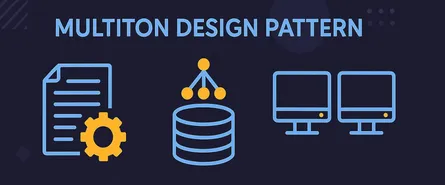
Mastering the Object Pool Design Pattern in C#: Boost Your Application’s Performance
- Sudhir mangla
- Design Patterns
- 25 Mar, 2025
Have you ever faced a situation where creating new objects repeatedly turned your shiny, fast application into a sluggish turtle? Creating objects can be expensive—especially when dealing with resources like database connections, threads, or large data structures. Here’s a question to ponder: Wouldn’t it be amazing if you had a handy bucket of ready-to-go objects whenever you needed them, without the overhead of creating them each time? That’s precisely what the Object Pool Design Pattern does!
In this article, we’ll dive headfirst into this practical design pattern. By the end, you’ll not only understand it deeply—you’ll also know exactly how to implement it yourself in C#. Let’s jump right in!
🎯 What Is the Object Pool Pattern?
Imagine you’re at a bowling alley. Do you bring your own bowling pins? Of course not! The pins are always there, neatly arranged, ready to be knocked down, picked up, and reused again and again. Similarly, the Object Pool Pattern manages a pool of reusable objects instead of creating and destroying them repeatedly.
Simply put, an object pool:
- Holds a set of initialized, reusable objects.
- Provides objects when they’re needed.
- Takes objects back when you’re done.
- Ensures efficient resource management and boosts performance.
📌 Principles of the Object Pool Pattern
The core principles behind Object Pooling are straightforward:
- Reuse, Don’t Recreate: Use existing objects repeatedly.
- Limit Resources: Control how many objects are active at any time.
- Pre-initialize Objects: Objects in the pool are created once, ready to use instantly.
- Manage Lifecycle: Carefully control object lifecycle, checking their health and validity.
🤔 When Should You Use Object Pooling?
Not every scenario demands an object pool. So, how do you know when to use it? Ask yourself these questions:
- Does your application frequently create and destroy expensive objects?
- Are object creation costs impacting your application’s performance?
- Do you have objects that can easily be reused without needing reinitialization?
If your answer is “yes” to any of these, congrats! You’ve found a perfect use case for the Object Pool Pattern.
⚙️ Key Components of an Object Pool
Let’s break down the pattern into essential components:
- Reusable Object: The object being pooled (database connections, threads, etc.).
- Pool Manager: Responsible for maintaining the lifecycle of the pooled objects.
- Client: The user of the pooled objects who borrows and returns them.
🚀 Implementation with C# Example
Let’s build a simple but robust implementation step-by-step:
Step 1: Create the reusable object (ReusableObject.cs):
public class ReusableObject
{
public int Id { get; private set; }
public bool IsInUse { get; private set; }
public ReusableObject(int id)
{
Id = id;
IsInUse = false;
}
public void Activate()
{
IsInUse = true;
Console.WriteLine($"Object {Id} is now active.");
}
public void Deactivate()
{
IsInUse = false;
Console.WriteLine($"Object {Id} has been deactivated and returned to pool.");
}
}Step 2: Implement the Object Pool (ObjectPool.cs):
public class ObjectPool
{
private readonly List<ReusableObject> _availableObjects;
private readonly List<ReusableObject> _usedObjects;
private readonly int _maxPoolSize;
public ObjectPool(int maxPoolSize)
{
_maxPoolSize = maxPoolSize;
_availableObjects = new List<ReusableObject>();
_usedObjects = new List<ReusableObject>();
for (int i = 0; i < _maxPoolSize; i++)
{
_availableObjects.Add(new ReusableObject(i));
}
}
public ReusableObject AcquireObject()
{
if (_availableObjects.Count == 0)
{
Console.WriteLine("No available objects in the pool!");
return null;
}
var obj = _availableObjects[0];
_availableObjects.RemoveAt(0);
_usedObjects.Add(obj);
obj.Activate();
return obj;
}
public void ReleaseObject(ReusableObject obj)
{
obj.Deactivate();
_usedObjects.Remove(obj);
_availableObjects.Add(obj);
}
}Step 3: Use the pool (Program.cs):
class Program
{
static void Main(string[] args)
{
ObjectPool pool = new ObjectPool(3);
var obj1 = pool.AcquireObject();
var obj2 = pool.AcquireObject();
pool.ReleaseObject(obj1);
var obj3 = pool.AcquireObject();
var obj4 = pool.AcquireObject();
var obj5 = pool.AcquireObject(); // Will indicate no objects available
}
}🚧 Different Ways to Implement Object Pooling
Implementing an Object Pool isn’t just a “one-size-fits-all” approach—there are several cool ways to customize it depending on your needs. Let’s check out a few common and handy methods.
🔹 1. Thread-Safe Object Pool
If your application is multi-threaded, multiple threads might fight over objects like siblings fighting over candy. To stop the chaos, you need a thread-safe object pool:
public class ThreadSafeObjectPool<T> where T : new()
{
private readonly ConcurrentBag<T> _objects = new ConcurrentBag<T>();
private int _currentCount = 0;
private readonly int _maxSize;
public ThreadSafeObjectPool(int maxSize)
{
_maxSize = maxSize;
}
public T GetObject()
{
if (_objects.TryTake(out var item))
return item;
if (_currentCount < _maxSize)
{
Interlocked.Increment(ref _currentCount);
return new T();
}
throw new InvalidOperationException("Object pool exhausted!");
}
public void ReturnObject(T item)
{
_objects.Add(item);
}
}Why it works: ConcurrentBag is like a magic bag—safe and efficient even if multiple threads are grabbing and tossing objects at once!
🔹 2. Lazy Initialization Pool
Sometimes your application might rarely use certain objects. You wouldn’t bake ten cakes just in case guests might show up, right? Lazy initialization creates objects only when they’re truly needed:
public class LazyObjectPool<T> where T : new()
{
private readonly Stack<T> _pool = new Stack<T>();
private readonly int _maxSize;
public LazyObjectPool(int maxSize)
{
_maxSize = maxSize;
}
public T GetObject()
{
return _pool.Count > 0 ? _pool.Pop() : new T();
}
public void ReturnObject(T item)
{
if (_pool.Count < _maxSize)
_pool.Push(item);
}
}Why it works: Objects are created just-in-time, saving memory and resources until truly needed.
🔹 3. Timed-Expiration Pool (Auto-Cleanup)
What if you want your objects to automatically vanish after a certain amount of inactivity? Like a ghost, they disappear quietly when unused:
public class TimedObject<T>
{
public T Instance { get; }
public DateTime LastUsed { get; private set; }
public TimedObject(T instance)
{
Instance = instance;
LastUsed = DateTime.Now;
}
public void Refresh() => LastUsed = DateTime.Now;
}
public class TimedExpirationPool<T> where T : new()
{
private readonly List<TimedObject<T>> _pool = new List<TimedObject<T>>();
private readonly int _expirationSeconds;
public TimedExpirationPool(int expirationSeconds)
{
_expirationSeconds = expirationSeconds;
}
public T GetObject()
{
lock (_pool)
{
CleanupExpiredObjects();
var obj = _pool.FirstOrDefault();
if (obj != null)
{
_pool.Remove(obj);
return obj.Instance;
}
return new T();
}
}
public void ReturnObject(T obj)
{
lock (_pool)
{
_pool.Add(new TimedObject<T>(obj));
}
}
private void CleanupExpiredObjects()
{
_pool.RemoveAll(o => (DateTime.Now - o.LastUsed).TotalSeconds > _expirationSeconds);
}
}Why it works: Automatically discarding unused objects helps avoid unnecessary memory use, keeping your application lean and tidy!
🎯 Real-World Use Cases (Let’s get practical!)
Here’s exactly when you’d love to have object pooling at your side:
-
Database Connections: Imagine opening a new database connection every single query. Sounds exhausting! Pooling keeps these connections ready for instant reuse, dramatically reducing wait times and load.
-
Game Development (Bullets, Enemies, Particles): Picture yourself as a game developer. Constantly creating and destroying bullets, enemies, or visual effects is like constantly buying new cars instead of refueling the old ones. A pool lets you reuse these objects efficiently, ensuring smooth gameplay and high FPS!
-
Network Connections: For web apps or APIs that handle lots of requests, pooling sockets or network connections prevents the overhead of constant reconnections. It’s like having taxis ready at a taxi stand instead of calling one each time.
-
Thread Pools: Managing threads is expensive. Pooling threads to handle multiple tasks allows your application to juggle multiple responsibilities gracefully without constant thread creation overhead.
✅ Advantages of Object Pooling (Why should you care?)
Here’s why this design pattern earns a special place in your toolkit:
-
Improved Performance: By skipping expensive object initialization, your app becomes faster and more responsive.
-
Resource Efficiency: Pooling conserves memory and resources. It’s the software equivalent of recycling—good for your app and your server’s health!
-
Predictability & Stability: With controlled object counts, your app behaves predictably, avoiding nasty resource exhaustion issues like memory leaks or too many open connections.
-
Scalability Boost: Object pools help your applications scale better. Think of it as preparing a meal in advance—when guests arrive, dinner is instantly ready!
⚠️ Disadvantages of Object Pooling (Nothing’s perfect, right?)
Before you jump in headfirst, let’s also check out the pitfalls:
-
Complexity Overhead: Pool management adds extra complexity. You must carefully handle object creation, usage, cleanup, and recycling. It’s like managing a busy restaurant kitchen; it works wonderfully but takes careful coordination.
-
Potential for Memory Leaks: If objects aren’t correctly returned to the pool, resources might leak silently, eating away at memory. Proper implementation is crucial!
-
Stale Object Issues: Reusing objects might mean carrying over outdated states or data from previous uses. You must ensure proper resetting and cleaning to avoid bugs.
-
Synchronization Overhead (Multithreading): In multithreaded applications, synchronization mechanisms add additional overhead. It’s necessary—but can slightly reduce performance benefits if not handled properly.
🌟 Wrapping Up (Conclusion)
The Object Pool Design Pattern is a game changer. When correctly implemented, it can significantly boost your application’s performance, especially when handling expensive or frequently reused resources. But like any powerful tool, it must be used wisely and judiciously to avoid unnecessary complexity or hidden pitfalls.
So next time your application feels sluggish or resource-intensive, don’t just create—recycle! Embrace the Object Pool Design Pattern, and watch your app become leaner, faster, and far more responsive. Your users—and your servers—will thank you!





